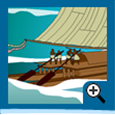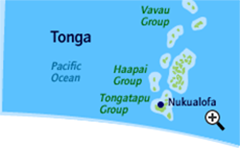The Canoe Is the People
Indigenous Navigation in the Pacific
Knowing and Adjusting Position
Over many kilometres of ocean, a wayfinder needs to keep track of his canoe’s position in relation to his home and destination so that he can change his course if necessary. To do this, he needs to carefully observe his heading GLOSSARY heading - the course or direction in which a boat is steered (different from its course made good) and speed. He also needs to know how the leeway GLOSSARY leeway - the sideways movement of a boat, caused by the wind and currents GLOSSARY currents - directional flow of the sea can push him off course and affect his speed.
He puts all this information together to estimate GLOSSARY estimate - work out, calculate his position at any time. There are different ways of doing this.
• Before modern equipment like the GPS GLOSSARY Global Positioning System (GPS) - a handheld computer that tells your position by communicating with satellites , western navigators used a way called dead reckoning.
• Pacific wayfinders use dead reckoning, but they have also developed a very different way to track their position. The best known way is the etak system used in Satawal and other Carolinian islands.
The real test is when a storm blows a vaka off course for days: the wayfinder must then use ancestral connections and intuition GLOSSARY intuition - knowing without having to think as well as skill and experience to keep track of where to go. For emergencies like bad weather, a navigator must always know which is the way to other islands are and the paths to them.
The Voyage of Moala Lahi (Tonga, Polynesia)
This story tells how a wayfinder had to change his path because of bad winds. Akauola was the head wayfinder from the Haa Fokololo oe Hau tribe in Tonga. Once, one of his kau moala (team of wayfinders and sailors) called Moala Lahi was sailing home to Vavau from Fiji with a group of kalia (double hulls). The journey was in a north-east direction. The winds became bad, and the vakas were separated, so Moala Lahi turned for Samoa in a north north-east direction. But the winds changed again, so he turned to Uvea (Wallis and Futuna) in a north-west direction, and he his vaka arrived there. The Uvean people helped him with his canoe. In return, he gave them what he was carrying. When the winds improved, he sailed back to Fiji for more supplies. Finally, he went on and arrived safely in Vavau.










